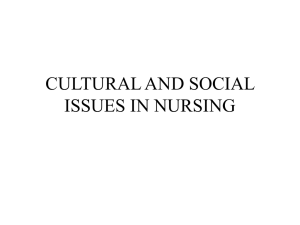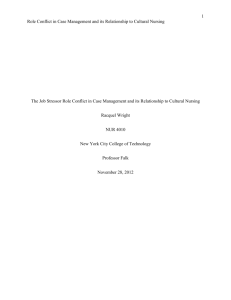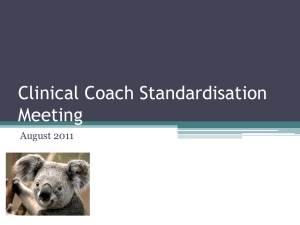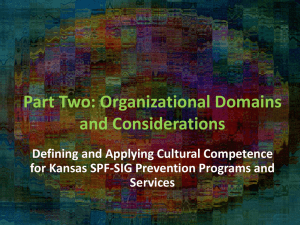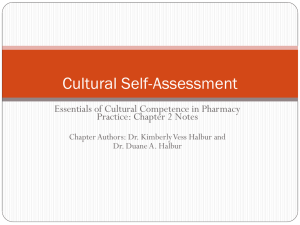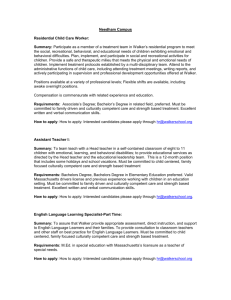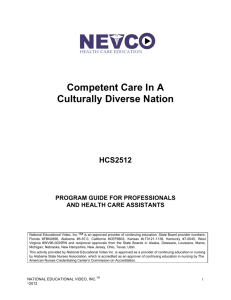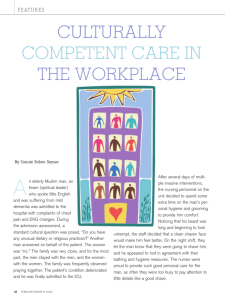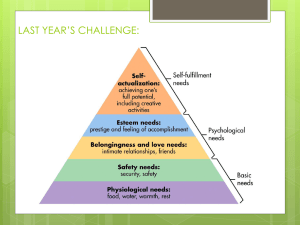Clincal Simms Community Health 1-14-08
advertisement
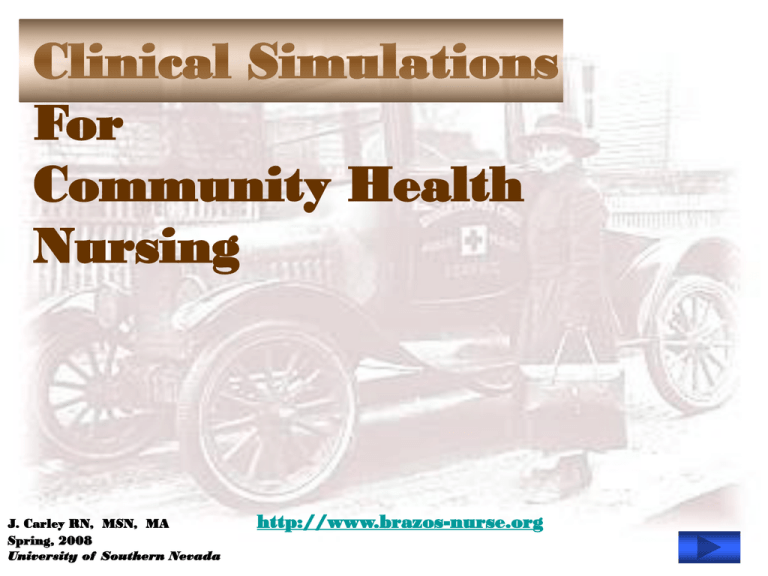
Clinical Simulations For Community Health Nursing J. Carley RN, MSN, MA Spring, 2008 University of Southern Nevada http://www.brazos-nurse.org Read Me First ! A Note or Two About This Presentation: • This presentation is made for viewing and interaction on an individual and personal level. Therefore, some often taken for granted tenets of “Power Point-ism” will be ignored or flatly violated. For instance, when giving a Power Point presentation for a class or group, the rule of thumb is generally that one only put “Bullets,” or short phrases on the slides, then fill in the information with lecture and discussion. Since this is an individual assignment, this tenet will be ignored at times, and much more information than usual will be presented on the slides—including whole paragraphs. • Additionally, each slide will generally be set to run through the animations automatically. In most cases, in order for the slides to progress smoothly, you should not click the mouse until the navigation arrow appears in the lower right hand corner of each slide. • Hyperlinks within the program itself and links to world wide web sites have been added: these will only work when you are playing the slide show presentation which you may access by clicking “Slide Show,” in the top navigation bar, followed by the drop down command: “View Show.” • Much of the information on the following slides have been gleaned from a variety of sources, especially the State of Vermont’s Public Health Nursing Orientation Curriculum. Citations have been made as they occur within the program. • Enjoy and learn. The Three Core Functions of Public Health Click on link, above for further information on the Core Functions of Public Health • Assessment • Policy Development • Assurance Assessment Policy Development Assurance Content Links Directions: Click on the link for each exercise, following the arrow prompts to advance or retreat through slides. If there is no “forward arrow,” then follow the link provided or return to this page. Internet access is required to complete many of these modules. **At the end of each module, (or on any page) click on the return icon to return to this home page. (NOTE: Hyperlinks only work when “slide show” is playing.) • • • • • • • • • • • • • Epidemiology in the Classroom Environmental Case Study Scorecard: The Pollution Information Site Outbreak at Water’s Edge Is Our Public Health System Equipped to Handle Disaster? Prevention / Health Promotion Bioterrorism : Dark Winter Exercise Disaster Management : Cultural Competence Critical Thinking in Public Health Systems Thinking MCH Exercise– Immunization Chronic Disease Intervention Instructions for Completing the ClinSimms Work Sheet: a. Complete Items I-IV, answering questions and following directions as provided. b. Choose (at least) one activity from Items V-VIII and complete work sheet, answering questions and providing answers as directed. c. Turn in your worksheet prior to leaving campus. • Epidemiology in the Classroom: • An Introduction to Epidemiology (1 hour) • Go to http://www.cdc.gov/excite/PDF/intro_epi.pdf to complete this reading. Environment Environmental Case Study • A 35-year-old mother, Mrs. Pearson, comes to your public health clinic with her four children. • She’s been to the clinic before and has lived in this rural, lakeside town all her life. Her husband is a fisherman. He brings home food from his daily catch. As the nurse in the clinic, your nutritional assessment indicates the family eats fish about four times a week. • In the past three weeks, Mrs. Pearson and her daughter Sally, age 7, have been feeling sick with headaches, malaise, nausea, and vomiting. Because of her symptoms, Mrs. Pearson believes she’s pregnant again. She thinks Sally’s symptoms are due to the sudden, unexplained deaths of her cat and dog to whom she was much attached. • Both the cat and dog were acting oddly before they died. The veterinarian thinks they may have been suffering from some type of seizure disorder. Environmental Case Study (continued) • Everyone else is healthy, except her husband. Recently, he’s been complaining of occasional numbness around the mouth and fingertips. But he says everyone that fishes with him feels the same way. Mrs. Pearson thinks it’s due to his occasional alcohol use or just old age. She said he’s been staggering and losing his balance lately, and he certainly seems not to hear as well as he used to. • Mrs. Pearson is aware of some newspaper stories and warnings that the fish is not safe to eat. But she says she doesn’t believe them because she and her family have been eating the fish from the nearby lakes for generations without any problems. It’s just another effort by the media to get everyone all riled up. Besides even if she wanted to, she can’t afford to buy meat at the supermarket. • She explains she just wants to complete her WIC interview in order to get her food delivery. She states she is not feeling well. Her daughter appears dehydrated and lethargic. READING: The “IPREPARE MODEL” (Click Link to Read) •Paranzino GK, Butterfield PB, Becker J, Ranger C, editors. I PREPARE Environmental Exposure History Mnemonic. Atlanta (GA): Agency for Toxic Substances and Disease Registry; 2000. Environmental Case Study Questions • 1. Using the “I PREPARE” model, identify three or four questions that you would ask Mrs. Pearson in order to obtain a more detailed family health history. • IPREPARE Mnemonic • 2. Mr. Pearson says all of his friends “feel this way.” Is this a trend that needs investigation? • 3. What data are available regarding fish safety in Nevada ? • 4. How can you link this individual assessment with populationbased health? (Hint: several individuals and friends have symptoms.) • Paranzino GK, Butterfield PB, Becker J, Ranger C, editors. I PREPARE Environmental Exposure History Mnemonic. Atlanta (GA): Agency for Toxic Substances and Disease Registry; 2000. Assignment: On a sheet of paper, write your answers to the above questions. Provide specific citations where relevant & required. “Outbreak at Water’s Edge” • Reflect upon your trip to the Waste Water Treatment Plant in Las Vegas. • Read the next page of this presentation, noting the questions you need to answer in regard to “Outbreak at Water’s Edge.” • With this and other concepts of community health in mind—including the three core functions of assessment, policy development, and assurance --go to the website listed on the next slide, interacting and reflecting on the questions listed on the next page. “Outbreak at Water’s Edge” • (1) Name each member of the public health team in this exercise, including their duties and job description. • (2) Describe the activity, including surveillance, investigation, and follow-up. • (3) Although the title of this exercise would seem to indicate that a water-borne illness is in play, what other types of illnesses (sources) must be addressed to ensure that the outbreak is properly studied? • (4) Which model would be most useful in studying this problem? (e.g., Epidemiological Triangle, Web of Causation, others…) • (5) What is your perception of this website in relation to meeting the educational needs of the new Public Health Nurse? Is it helpful? Outbreak at Water’s Edge: http://mclph.umn.edu/watersedge/ Is Our Public Health System Equipped to Handle a Disaster? • View the webcast ( 7 minutes) by Dr. Kristine Gebbie: http://www.columbia.edu/cu/news/media/02/kristineGebb ie • Supplementary Reading / Resource: • Disaster Response: Principles of Preparation and Coordination (Chapters 1-2 of this online text). Erik auf der Heide. Center for Excellence in Disaster Management and Humanitarian Assistance • Reflect on the reading and the following definition of critical thinking in nursing: • • “Unlike the ‘mindless’ thinking we do when we go about our daily routines, critical thinking is purposeful, goal-directed thinking that aims to make judgments based on evidence (fact), rather than conjecture (guess work). Based on principles of science and the scientific method (e.g., maintaining a questioning attitude, following an organized approach to discovery, and making sure information is reliable), critical thinking requires developing strategies that maximize human potential (e.g., tapping on individual strengths) and compensate for problems caused by human nature (e.g. the powerful influence of personal perceptions, values, and beliefs).” • 1. How do public health nurses apply critical thinking to the analysis and interpretation of data? • 2. How do public health nurses support critical thinking in their work with community partners to define health priorities? Prevention / Health Promotion • Go to the article: • A Guide to Community Preventive Services: • See http://www.thecommunityguide.org for a list of community organization resources. • Develop an outline of relevant information from these resources (or others that you research) that you could use to assist the community in planning a local response to a FIT and Healthy Kids Initiative. • Review the Best Practice Checklist (next page) as a guide. • Best Practice Checklist • Questions to ask when researching intervention options: • 1 Where has this intervention been tried before, and what has been the outcome? • 2 What does expert opinion say on the probability of this intervention being successful? • 3 Have there been research studies showing that this intervention works or is likely to work? • 4 Does this situation match others where this intervention has been successful? • 5 Does this community have experience using this kind of intervention? Systems Thinking • Read this overview of systems thinking by Daniel Aronson: • http://www.thinking.net/Systems_Thinking/Intro_to_ST/intro_to_st.html • Most of the challenges that public health nurses face are complex and do not have easy solutions. You have already read about critical thinking. Systems thinking is a critical-thinking approach. Using a systems- thinking approach will enable you to look at all of the component parts and multiple perspectives. • Try a critical-thinking/systems-thinking approach in the following activity (next page). Case Study • Health data for your community indicates that intravenous heroin use is on the rise. The potential for an increase in blood borne diseases such as hepatitis and HIV are of concern. • You have been asked to facilitate a community group that will be considering the need for one of two services that are currently unavailable in your service delivery area: • A mobile opiate treatment clinic • A needle exchange program • What public health nursing interventions and essential public health service will you use in completing this work? Case Study (cont.) • You are scheduled to facilitate a discussion with community partners about the feasibility of providing this service in your community. Use critical thinking and a systems-thinking approach to develop a list of issues and assumptions, as well as information and resources that you will need to explore before your meeting. • 1. What are some of the issues you anticipate will be raised by your partners? 2. What assumptions are you making about concerns they may raise? 3. What assumptions do you think they may come to the meeting with? 4. What data and other information do you want to have on hand to share with them? • • • • • For this activity you are being asked to create a research “to do list “only. You do not need to have the answers to your questions. Go to the next page. Rabinowitz P. & Fawcett S, editor. Thinking Critically. University of Kansas Community Tool Box. Available at: http://ctb.ku.edu/tools/en/sub_section_main_1120.htm. Critical Thinking • Reminder: Some goals of critical thinking: • Truth: to separate what is true from what is false, partially true, incomplete, slanted, based on false premises, or assumed to be true because "everyone says so." • Context: to consider the context and history of issues, problems, or situations. • Assumptions: to understand the assumptions and purposes behind information or situations. • Alternatives: to create ways of approaching problems, issues, and situations that address the real, rather than assumed or imagined, factors that underlie or directly cause them -- even when those factors turn out to be different from what you expected.* • *Rabinowitz P. Fawcett S, editor. Thinking Critically. University of Kansas Community Tool Box. http://ctb.ku.edu/tools/en/sub_section_main_1120.htm Cultural Competency Objectives: • Identify the role of cultural, social, and behavioral factors in determining the delivery of public health services. • Understand the importance of a diverse public health workforce. • Utilize appropriate methods for interacting sensitively, effectively, and professionally with persons from diverse cultural, socioeconomic, educational, racial, ethnic, and professional backgrounds, and persons of all ages and lifestyles. • • • • • Cultural diversity relates to race and ethnicity as well as regional patterns and educational and economic factors. The demographics in Nevada show a large number of minorities in the population as a whole, so we must be cognizant of some crucial differences. Cultural diversity manifests itself in many ways, including race, ethnicity, education, rural lifestyle, poverty. This lesson will provide a brief overview of cultural competency and discuss national initiatives that focus on health literacy and the prevention of health disparities. The assurance function of public health includes exploring accessibility and acceptability issues for all members of a community. If health services are not accessible because of language or cultural barriers, the public health nurse plays a key role in adapting services to meet the needs of all. The National Standards for Culturally Competent Care define cultural and linguistic competence as a set of congruent behaviors, attitudes, and policies that come together in a system, agency, or among professionals that enable effective work in cross cultural situations. Culture refers to integrated patterns of human behavior that include the language, thoughts, communications, actions, customs, beliefs, values, and institutions of racial, ethnic, religious or social groups. Competence implies having the capacity to function effectively as an individual and an organization within the context of the cultural beliefs, behaviors, and needs presented by consumers and their communities. (The Office of Minority Health has also added gender, sexual orientation, age, disability, socioeconomic status, linguistic-minority status, low literacy skills, and hearing impairment.) NOTE: The Culturally Competent Nursing Modules Project Is available for CNE (free of charge) at the link below. • • • • • • • In Culturally Competent Care, a concept paper written for the Culturally Competent Nursing Modules Project, the author outlines the skills needed by nurses in order to provide a cross- cultural approach as defined in the literature. They include: · “Being able to recognize the components of one’s own culture formation, and their potential impact on one’s practice, including the risk of projecting onto patients.” “Applied familiarity with models for ascertaining cross cultural understandings of illness, health and care. Such familiarity is related to skills for eliciting patient’s explanatory models and related world views, sometimes formulated as patient’s “health beliefs”. These skills are crucial for developing greater understanding, enhancing communication, learning, and adherence.”* “Being able to discuss CAM, complimentary and alternative medicine, with patients, and knowing how to locate information about related modalities.” “Eliciting the patient’s social context, including stressors and supports, and their impact on the patient’s health and sense of well being.” “Becoming able to work across cultural differences: forming a relationship, patient – centered interviewing, assessment, addressing conflict, negotiation, and case management.” • The article concluded that, “Growing competence in communication skills occurs as learners’ transition from one stage to the next. All these strategies involve negotiation, and jettisoning in the pursuit of patient “compliance” in favor of compromises that address the goals most deeply at stake for each party.” • Another skill addressed in the paper is the ability to recognize ways in which certain forms of social power and privilege can lead unconsciously to the perpetuation of disparities. • The concept paper defines the need for training and skill development. Training modules will be developed to address those needs. • In addition to providing culturally competent care, linguistically competent care is also a need for those with low literacy or Limited English Proficiency (LEP). • Title 6 of the Civil Rights Law, recent guidance by the Department of Justice, and the National Standards for Culturally and Linguistically Appropriate Services define expectations for institutions and individuals regarding access to language assistance. Additionally, Healthy People 2010 proposes the elimination of health disparities and in objective (11-2), Health Communication, stresses the improvement of health literacy for all persons. Cultural Competence • Assignment: • Go to : Culturally Competent Nursing Modules Project • Following the directions on the web site, register for Module 1, complete the activity, then print a copy of the completion certificate after you finish the post-test. • Turn in a copy of the certificate. View Power Point Presentation: “Dark Winter”
